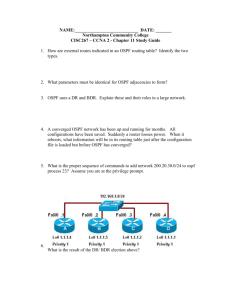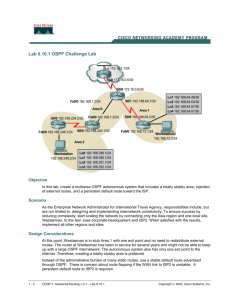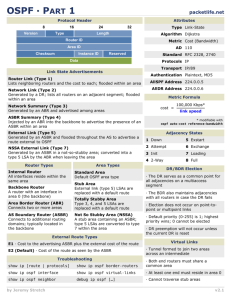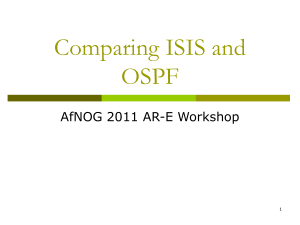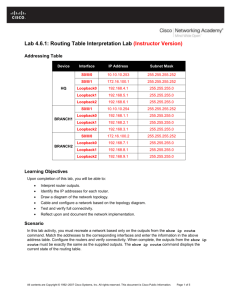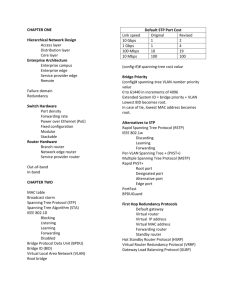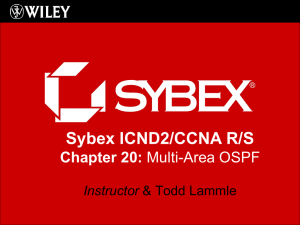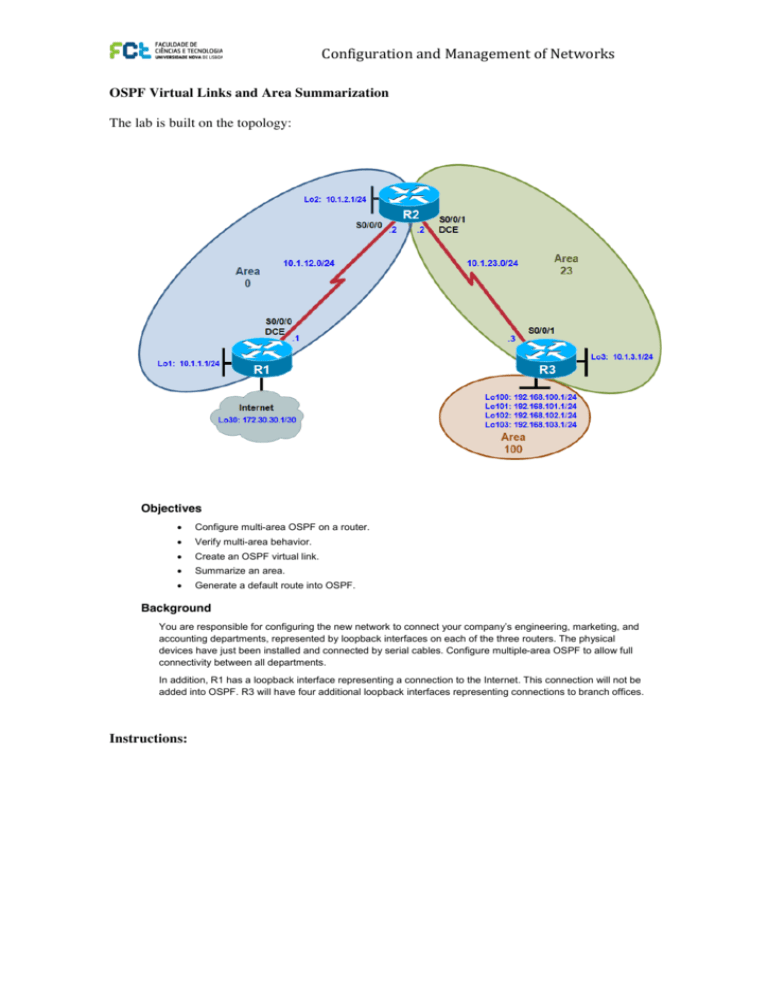
Configuration and Management of Networks CCNPv6 ROUTE
OSPF Virtual Links and Area Summarization
CCNPv6
ROUTE
TheChapter
lab
is built
the topology:
3onLab
3-3, OSPF
Virtual Links and Area Summarization
Topology
Chapter 3 Lab 3-3, OSPF Virtual Links and Area Summarization
Topology
Objectives
!
Configure multi-area OSPF on a router.
Objectives
!
!
!
!
!
!
!
!
Verify multi-area behavior.
Configure multi-area OSPF on a router.
Create an OSPF virtual link.
Verify multi-area behavior.
Summarize an area.
Create an OSPF virtual link.
Generate a default route into OSPF.
Summarize an area.
! Generate a default route into OSPF.
Background
You are responsible for configuring the new network to connect your company’s engineering, marketing, and
Background
accounting departments, represented by loopback interfaces on each of the three routers. The physical
You are responsible for configuring the new network to connect your company’s engineering, marketing, and
devices have just been installed and connected by serial cables. Configure multiple-area OSPF to allow full
accounting departments, represented by loopback interfaces on each of the three routers. The physical
connectivity between all departments.
devices have just been installed and connected by serial cables. Configure multiple-area OSPF to allow full
all departments.
Inconnectivity
addition, R1between
has a loopback
interface representing a connection to the Internet. This connection will not be
added
into OSPF.
R3
will have interface
four additional
loopback
interfacestorepresenting
connections
to branch
offices.
In addition,
R1 has
a loopback
representing
a connection
the Internet. This
connection
will not be
added into OSPF. R3 will have four additional loopback interfaces representing connections to branch offices.
All contents are Copyright © 1992–2010 Cisco Systems, Inc. All rights reserved. This document is Cisco Public Information.
All contents are Copyright © 1992–2010 Cisco Systems, Inc. All rights reserved. This document is Cisco Public Information.
Instructions:
Page 1 of 11
Page 1 of 11
model and Cisco IOS Software version, the commands available and output produced might vary from what is
shown in this lab.
Required Resources
!
(Cisco
1841
with
Cisco
Configuration and MAdvanced
anagement of Noretworks 3 routers
IOS Release 12.4(24)T1
IP Services
comparable)
!
Serial and console cables
Step 1: Configure addressing and loopbacks.
Using the addressing scheme in the diagram, apply IP addresses to the serial interfaces on R1, R2, and R3.
Create loopbacks on R1, R2, and R3, and address them according to the diagram.
R1# configure terminal
Enter configuration commands, one per line. End with CNTL/Z.
R1(config)# interface loopback 1
R1(config-if)# description Engineering Department
R1(config-if)# ip address 10.1.1.1 255.255.255.0
R1(config-if)# interface loopback 30
R1(config-if)# ip address 172.30.30.1 255.255.255.252
R1(config-if)# interface serial 0/0/0
R1(config-if)# ip address 10.1.12.1 255.255.255.0
R1(config-if)# clockrate 64000
R1(config-if)# no shutdown
R2# configure terminal
Enter configuration commands, one per line. End with CNTL/Z.
R2(config)# interface loopback 2
R2(config-if)# description Marketing Department
R2(config-if)# ip address 10.1.2.1 255.255.255.0
R2(config-if)# interface serial 0/0/0
R2(config-if)# ip address 10.1.12.2 255.255.255.0
R2(config-if)# no shutdown
R2(config-if)# interface serial 0/0/1
R2(config-if)# ip address 10.1.23.2 255.255.255.0
R2(config-if)# clockrate 64000
R2(config-if)# no shutdown
R3# configure terminal
Enter configuration commands, one per line. End with CNTL/Z.
R3(config)# interface loopback 3
R3(config-if)# description Accounting Department
R3(config-if)# ip address 10.1.3.1 255.255.255.0
R3(config-if)# interface loopback 100
R3(config-if)# ip address 192.168.100.1 255.255.255.0
R3(config-if)# interface loopback 101
R3(config-if)# ip address 192.168.101.1 255.255.255.0
R3(config-if)# interface loopback 102
R3(config-if)# ip address 192.168.102.1 255.255.255.0
R3(config-if)# interface loopback 103
R3(config-if)# ip address 192.168.103.1 255.255.255.0
R3(config-if)# interface serial 0/0/1
R3(config-if)# ip address 10.1.23.3 255.255.255.0
CCNPv6R3(config-if)#
ROUTE
no shutdown
Step 2: Add interfaces into OSPF.
All contents are Copyright © 1992–2010 Cisco Systems, Inc. All rights reserved. This document is Cisco Public Information.
Page 2 of 11
a. Create OSPF process 1 on all three routers. Using the network command, configure the subnet of the
serial link between R1 and R2 to be in OSPF area 0. Add loopback 1 on R1 and loopback 2 on R2 into
OSPF area 0.
Note: The default behavior of OSPF for loopback interfaces is to advertise a 32-bit host route. To ensure
that the full /24 network is advertised, use the ip ospf network point-to-point command. Change the
network type on the loopback interfaces so that they are advertised with the correct subnet.
R1(config)# router ospf 1
R1(config-router)# network 10.1.12.0 0.0.0.255 area 0
R1(config-router)# network 10.1.1.0 0.0.0.255 area 0
R1(config-router)# exit
R1(config)# interface loopback 1
R1(config-if)# ip ospf network point-to-point
R2(config)# router ospf 1
R2(config-router)# network 10.1.12.0 0.0.0.255 area 0
R2(config-router)# network 10.1.2.0 0.0.0.255 area 0
R2(config-router)# exit
R2(config)# interface loopback 2
R2(config-if)# ip ospf network point-to-point
b. Verify that you can see OSPF neighbors in the show ip ospf neighbors output on both routers. Verify
that the routers can see each other’s loopback with the show ip route command.
R1# show ip ospf neighbor
Neighbor ID
10.1.2.1
Pri
0
State
FULL/
-
Dead Time
00:00:38
Address
10.1.12.2
Interface
Serial0/0/0
R1# show ip route
Codes: C - connected, S - static, R - RIP, M - mobile, B - BGP
D - EIGRP, EX - EIGRP external, O - OSPF, IA - OSPF inter area
N1 - OSPF NSSA external type 1, N2 - OSPF NSSA external type 2
E1 - OSPF external type 1, E2 - OSPF external type 2
i - IS-IS, su - IS-IS summary, L1 - IS-IS level-1, L2 - IS-IS level-2
R1(config-if)# ip ospf network point-to-point
R2(config)# router ospf 1
R2(config-router)# network 10.1.12.0 0.0.0.255 area 0
R2(config-router)# network 10.1.2.0 0.0.0.255 area 0
exit
Configuration and Management of Networks R2(config-router)#
R2(config)# interface loopback 2
R2(config-if)# ip ospf network point-to-point
b. Verify that you can see OSPF neighbors in the show ip ospf neighbors output on both routers. Verify
that the routers can see each other’s loopback with the show ip route command.
R1# show ip ospf neighbor
Neighbor ID
10.1.2.1
Pri
0
State
FULL/
-
Dead Time
00:00:38
Address
10.1.12.2
Interface
Serial0/0/0
R1# show ip route
Codes: C - connected, S - static, R - RIP, M - mobile, B - BGP
D - EIGRP, EX - EIGRP external, O - OSPF, IA - OSPF inter area
N1 - OSPF NSSA external type 1, N2 - OSPF NSSA external type 2
E1 - OSPF external type 1, E2 - OSPF external type 2
i - IS-IS, su - IS-IS summary, L1 - IS-IS level-1, L2 - IS-IS level-2
ia - IS-IS inter area, * - candidate default, U - per-user static
route
o - ODR, P - periodic downloaded static route
Gateway of last resort is not set
C
O
C
C
10.0.0.0/24 is subnetted, 3 subnets
10.1.12.0 is directly connected, Serial0/0/0
10.1.2.0 [110/65] via 10.1.12.2, 00:00:10, Serial0/0/0
10.1.1.0 is directly connected, Loopback1
172.30.0.0/30 is subnetted, 1 subnets
172.30.30.0 is directly connected, Loopback30
R2# show ip ospf neighbor
Neighbor ID
172.30.30.1
Pri
0
State
FULL/
-
Dead Time
00:00:35
Address
10.1.12.1
Interface
Serial0/0/0
R2# show ip route
Codes: C - connected, S - static, R - RIP, M - mobile, B - BGP
CCNPv6
CCNPv6 ROUTE
ROUTE D - EIGRP, EX - EIGRP external, O - OSPF, IA - OSPF inter area
N1 - OSPF NSSA external type 1, N2 - OSPF NSSA external type
type 2
2
Page 3 of 11
E1 - OSPF external type 1, E2 - OSPF external type 2
E1 - OSPF external type 1, E2 - OSPF external type 2
i - IS-IS, su - IS-IS summary, L1 - IS-IS level-1, L2 - IS-IS level-2
i - IS-IS, su - IS-IS summary, L1 - IS-IS level-1, L2 - IS-IS level-2
ia - IS-IS inter area, * - candidate default, U - per-user static
ia - IS-IS inter area, * - candidate default, U - per-user static
N1© 1992–2010
- OSPFCisco
NSSA
external
N2 - OSPF
NSSAInformation.
external
All contents are Copyright
Systems,
Inc. All rights type
reserved.1,
This document
is Cisco Public
route
route
o - ODR, P - periodic downloaded static route
o - ODR, P - periodic downloaded static route
Gateway of last resort is not set
Gateway of last resort is not set
c.
c.
10.0.0.0/24 is subnetted, 4 subnets
10.0.0.0/24 is subnetted, 4 subnets
C
10.1.12.0 is directly connected, Serial0/0/0
C
10.1.12.0 is directly connected, Serial0/0/0
C
10.1.2.0 is directly connected, Loopback2
C
10.1.2.0 is directly connected, Loopback2
O
10.1.1.0 [110/65] via 10.1.12.1, 00:00:30, Serial0/0/0
O
10.1.1.0 [110/65] via 10.1.12.1, 00:00:30, Serial0/0/0
C
10.1.23.0 is directly connected, Serial0/0/1
C
10.1.23.0 is directly connected, Serial0/0/1
Add the subnet between R2 and R3 into OSPF area 23 using the network command. Add loopback 3 on
Add the subnet between R2 and R3 into OSPF area 23 using the network command. Add loopback 3 on
R3 into area 23.
R3 into area 23.
R2(config)# router ospf 1
R2(config)# router ospf 1
R2(config-router)# network 10.1.23.0 0.0.0.255 area 23
R2(config-router)# network 10.1.23.0 0.0.0.255 area 23
R3(config)# router ospf 1
R3(config)# router ospf 1
R3(config-router)# network 10.1.23.0 0.0.0.255 area 23
R3(config-router)# network 10.1.23.0 0.0.0.255 area 23
R3(config-router)# network 10.1.3.0 0.0.0.255 area 23
R3(config-router)# network 10.1.3.0 0.0.0.255 area 23
R3(config-router)# exit
R3(config-router)# exit
R3(config)# interface loopback 3
R3(config)# interface loopback 3
R3(config-if)# ip ospf network point-to-point
R3(config-if)# ip ospf network point-to-point
d. Verify that this neighbor relationship comes up with the show ip ospf neighbors command.
d. Verify that this neighbor relationship comes up with the show ip ospf neighbors command.
R2# show ip ospf neighbor
R2# show ip ospf neighbor
Neighbor ID
Pri
State
Dead Time
Address
Interface
Neighbor ID
Pri
State
Dead Time
Address
Interface
172.30.30.1
0
FULL/ 00:00:36
10.1.12.1
Serial0/0/0
172.30.30.1
0
FULL/ 00:00:36
10.1.12.1
Serial0/0/0
192.168.103.1
0
FULL/ 00:00:36
10.1.23.3
Serial0/0/1
192.168.103.1
0
FULL/ 00:00:36
10.1.23.3
Serial0/0/1
e. Using a Tcl script, verify connectivity to all interfaces from any router, with the exception of loopback 30
e. Using a Tcl script, verify connectivity to all interfaces from any router, with the exception of loopback 30
on R1, and R3 loopbacks 100 through 103.
on R1, and R3 loopbacks 100 through 103.
R1# tclsh
R1# tclsh
R1(tcl)#
R1(tcl)#
foreach address {
foreach address {
10.1.1.1
10.1.1.1
10.1.2.1
10.1.2.1
10.1.3.1
10.1.3.1
10.1.12.1
10.1.12.1
10.1.12.2
10.1.12.2
10.1.23.2
R2(config-router)# network 10.1.23.0 0.0.0.255 area 23
R3(config)# router ospf 1
R3(config-router)# network 10.1.23.0 0.0.0.255 area 23
R3(config-router)# network 10.1.3.0 0.0.0.255 area 23
exit
Configuration and Management of Networks R3(config-router)#
R3(config)# interface loopback 3
R3(config-if)# ip ospf network point-to-point
d. Verify that this neighbor relationship comes up with the show ip ospf neighbors command.
R2# show ip ospf neighbor
Neighbor ID
172.30.30.1
192.168.103.1
Pri
0
0
State
FULL/
FULL/
-
Dead Time
00:00:36
00:00:36
Address
10.1.12.1
10.1.23.3
Interface
Serial0/0/0
Serial0/0/1
e. Using a Tcl script, verify connectivity to all interfaces from any router, with the exception of loopback 30
on R1, and R3 loopbacks 100 through 103.
R1# tclsh
R1(tcl)#
foreach address {
10.1.1.1
10.1.2.1
10.1.3.1
10.1.12.1
10.1.12.2
10.1.23.2
10.1.23.3
172.30.30.1
192.168.100.1
192.168.101.1
192.168.102.1
192.168.103.1
Step 3: Create a virtual link.
a. Add loopbacks 100 through 103 on R3 to the OSPF process in area 100 using the network command.
CCNPv6 ROUTE
ROUTE
CCNPv6
Change the network type to advertise the correct subnet mask.
R3(config)# router ospf 1
R3(config-router)# network
network 192.168.100.0
192.168.100.0 0.0.3.255
0.0.3.255 area
area 100
100
R3(config-router)#
R3(config-router)# exit
exit
R3(config-router)#
R3(config)# interface
interface loopback
loopback 100
100
R3(config)#
R3(config-if)# ip
ip ospf
ospf network
network point-to-point
point-to-point
R3(config-if)#
R3(config-if)# interface
interface loopback
loopback 101
101
R3(config-if)#
R3(config-if)# ip
ip ospf
ospf network
network point-to-point
point-to-point
R3(config-if)#
R3(config-if)# interface
interface loopback
loopback 102
102
R3(config-if)#
R3(config-if)# ip
ip ospf
ospf network
network point-to-point
point-to-point
R3(config-if)#
R3(config-if)# interface
interface loopback
loopback 103
103
R3(config-if)#
R3(config-if)# ip
ip ospf
ospf network
network point-to-point
point-to-point
R3(config-if)#
router
ospf Inc.
1 All rights reserved. This document is Cisco Public Information.
All contentsR3(config)#
are Copyright © 1992–2010
Cisco Systems,
Page 4 of 11
b. Look
Look at
at the
the output
output of
of the
the show
show ip
ip route
route command
command on
on R2.
R2. Notice
Notice that
that the
the routes
routes to
to those
those networks
networks do
do not
not
b.
appear.
The
reason
for
this
behavior
is
that
area
100
on
R3
is
not
connected
to
the
backbone.
It
is
only
appear. The reason for this behavior is that area 100 on R3 is not connected to the backbone. It is only
connected to
to area
area 23.
23. If
If an
an area
area is
is not
not connected
connected to
to the
the backbone,
backbone, its
its routes
routes are
are not
not advertised
advertised outside
outside of
of
connected
its
area.
its area.
R2# show
show ip
ip route
route
R2#
Codes: C
C - connected,
connected, S
S - static,
static, R
R - RIP,
RIP, M
M - mobile,
mobile, B
B - BGP
BGP
Codes:
D
EIGRP,
EX
EIGRP
external,
O
OSPF,
IA
OSPF
inter
area
D - EIGRP, EX - EIGRP external, O - OSPF, IA - OSPF inter area
N1 - OSPF
OSPF NSSA
NSSA external
external type
type 1,
1, N2
N2 - OSPF
OSPF NSSA
NSSA external
external type
type 2
2
N1
E1 - OSPF
OSPF external
external type
type 1,
1, E2
E2 - OSPF
OSPF external
external type
type 2
2
E1
i - IS-IS,
IS-IS, su
su - IS-IS
IS-IS summary,
summary, L1
L1 - IS-IS
IS-IS level-1,
level-1, L2
L2 - IS-IS
IS-IS level-2
level-2
i
ia
IS-IS
inter
area,
*
candidate
default,
U
per-user
static
ia - IS-IS inter area, * - candidate default, U - per-user static
route
route
o - ODR,
ODR, P
P - periodic
periodic downloaded
downloaded static
static route
route
o
Gateway of
of last
last resort
resort is
is not
not set
set
Gateway
C
C
O
O
C
C
O
O
C
C
10.0.0.0/24 is
is subnetted,
subnetted, 5
5 subnets
subnets
10.0.0.0/24
10.1.12.0 is
is directly
directly connected,
connected, Serial0/0/0
Serial0/0/0
10.1.12.0
10.1.3.0
[110/65]
via
10.1.23.3,
00:01:00, Serial0/0/1
Serial0/0/1
10.1.3.0 [110/65] via 10.1.23.3, 00:01:00,
10.1.2.0 is
is directly
directly connected,
connected, Loopback2
Loopback2
10.1.2.0
10.1.1.0 [110/65]
[110/65] via
via 10.1.12.1,
10.1.12.1, 00:03:10,
00:03:10, Serial0/0/0
Serial0/0/0
10.1.1.0
10.1.23.0 is
is directly
directly connected,
connected, Serial0/0/1
Serial0/0/1
10.1.23.0
What would
would happen
happen ifif routes
routes could
could pass
pass between
between areas
areas without
without going
going through
through the
the backbone?
backbone?
What
_______________________________________________________________________________
_______________________________________________________________________________
_______________________________________________________________________________
_______________________________________________________________________________
_______________________________________________________________________________
_______________________________________________________________________________
You can
can get
get around
around this
this situation
situation by
by creating
creating a
a virtual
virtual link.
link. A
A virtual
virtual link
link is
is an
an OSPF
OSPF feature
feature that
that creates
creates a
a
You
logical extension
extension of
of the
the backbone
backbone area
area across
across a
a regular
regular area,
area, without
without actually
actually adding
adding any
any physical
physical
logical
interfaces into
into area
area 0.
0.
interfaces
Note: Prior
Prior to
to creating
creating a
a virtual
virtual link
link you
you need
need to
to identify
identify the
the OSPF
OSPF router
router ID
ID for
for the
the routers
routers involved
involved (R2
(R2
Note:
and R3),
R3), using
using a
a command
command such
such as
as show
show ip
ip ospf,
ospf, show
show ip
ip protocols
protocols or
or show
show ip
ip ospf
ospf interface.
interface. The
The
and
output for
for the
the show
show ip
ip ospf
ospf command
command on
on R1
R1 and
and R3
R3 is
is shown
shown below.
below.
output
R2# show
show ip
ip ospf
ospf
R2#
Gateway of last resort is not set
10.0.0.0/24 is subnetted, 5 subnets
10.1.12.0 is directly connected, Serial0/0/0
10.1.3.0 [110/65] via 10.1.23.3, 00:01:00, Serial0/0/1
10.1.2.0
connected, a
Loopback2
is
directly
Configuration nd Management of Networks 10.1.1.0 [110/65] via 10.1.12.1, 00:03:10, Serial0/0/0
10.1.23.0 is directly connected, Serial0/0/1
C
O
C
O
C
What would happen if routes could pass between areas without going through the backbone?
_______________________________________________________________________________
_______________________________________________________________________________
_______________________________________________________________________________
You can get around this situation by creating a virtual link. A virtual link is an OSPF feature that creates a
logical extension of the backbone area across a regular area, without actually adding any physical
interfaces into area 0.
Note: Prior to creating a virtual link you need to identify the OSPF router ID for the routers involved (R2
and R3), using a command such as show ip ospf, show ip protocols or show ip ospf interface. The
output for the show ip ospf command on R1 and R3 is shown below.
R2# show ip ospf
Routing Process "ospf 1" with ID 10.1.2.1
<output omitted>
show ip ospf
CCNPv6R3#
ROUTE
CCNPv6 ROUTE
Routing Process "ospf 1" with ID 192.168.103.1
<output omitted>
c. Create
a virtual
link Cisco
using
the area
virtual-link
router-id
OSPF configuration
All contents
are Copyright
© 1992–2010
Systems,
Inc. Alltransit_area
rights reserved. This
document is Cisco
Public Information.
c.
command
Page 5 ofon
11
Create a virtual link using the area transit_area virtual-link router-id OSPF configuration command
on
both R2 and R3.
both R2 and R3.
R2(config)# router ospf 1
R2(config)# router ospf 1
R2(config-router)# area 23 virtual-link 192.168.103.1
R2(config-router)# area 23 virtual-link 192.168.103.1
R3(config)# router ospf 1
R3(config)# router ospf 1
R3(config-router)# area 23 virtual-link 10.1.2.1
R3(config-router)# area 23 virtual-link 10.1.2.1
Note: To ensure that the router ID of the virtual link endpoints remains constant, you can statically
Note: To ensure that the router ID of the virtual link endpoints remains constant, you can statically
configure the OSPF router ID of the virtual link endpoints using the router-id command.
configure the OSPF router ID of the virtual link endpoints using the router-id command.
d. After you see the adjacency over the virtual interface come up, issue the show ip route command on R2
d. After you see the adjacency over the virtual interface come up, issue the show ip route command on R2
and see the routes from area 100. You can verify the virtual link with the show ip ospf neighbor and
and see the routes from area 100. You can verify the virtual link with the show ip ospf neighbor and
show ip ospf interface commands.
show ip ospf interface commands.
R2# show ip route
R2# show ip route
Codes: C - connected, S - static, R - RIP, M - mobile, B - BGP
Codes: C - connected, S - static, R - RIP, M - mobile, B - BGP
D - EIGRP, EX - EIGRP external, O - OSPF, IA - OSPF inter area
D - EIGRP, EX - EIGRP external, O - OSPF, IA - OSPF inter area
N1
- OSPF NSSA external type 1, N2 - OSPF NSSA external type 2
N1 - OSPF NSSA external type 1, N2 - OSPF NSSA external type 2
E1 - OSPF
OSPF external
external type
type 1,
1, E2
E2 - OSPF
OSPF external
external type
type 2
2
E1
i - IS-IS,
IS-IS, su
su - IS-IS
IS-IS summary,
summary, L1
L1 - IS-IS
IS-IS level-1,
level-1, L2
L2 - IS-IS
IS-IS level-2
level-2
i
ia
IS-IS
inter
area,
*
candidate
default,
U
per-user
static
ia - IS-IS inter area, * - candidate default, U - per-user static
route
route
o
- ODR,
ODR, P
P - periodic
periodic downloaded
downloaded static
static route
route
o Gateway of
of last
last resort
resort is
is not
not set
set
Gateway
C
C
O
O
C
C
O
O
C
C
O
O
O
O
O
O
O
O
IA
IA
IA
IA
IA
IA
IA
IA
10.0.0.0/24 is
is subnetted,
subnetted, 5
5 subnets
subnets
10.0.0.0/24
10.1.12.0
is
directly
connected,
Serial0/0/0
10.1.12.0 is directly connected, Serial0/0/0
10.1.3.0 [110/65]
[110/65] via
via 10.1.23.3,
10.1.23.3, 00:01:35,
00:01:35, Serial0/0/1
Serial0/0/1
10.1.3.0
10.1.2.0 is
is directly
directly connected,
connected, Loopback2
Loopback2
10.1.2.0
10.1.1.0 [110/65]
[110/65] via
via 10.1.12.1,
10.1.12.1, 00:01:35,
00:01:35, Serial0/0/0
Serial0/0/0
10.1.1.0
10.1.23.0 is
is directly
directly connected,
connected, Serial0/0/1
Serial0/0/1
10.1.23.0
192.168.102.0/24 [110/65]
[110/65] via
via 10.1.23.3,
10.1.23.3, 00:00:05,
00:00:05, Serial0/0/1
Serial0/0/1
192.168.102.0/24
192.168.103.0/24
[110/65]
via
10.1.23.3,
00:00:05,
Serial0/0/1
192.168.103.0/24 [110/65] via 10.1.23.3, 00:00:05, Serial0/0/1
192.168.100.0/24 [110/65]
[110/65] via
via 10.1.23.3,
10.1.23.3, 00:00:57,
00:00:57, Serial0/0/1
Serial0/0/1
192.168.100.0/24
192.168.101.0/24 [110/65]
[110/65] via
via 10.1.23.3,
10.1.23.3, 00:00:16,
00:00:16, Serial0/0/1
Serial0/0/1
192.168.101.0/24
R2# show
show ip
ip ospf
ospf neighbor
neighbor
R2#
Neighbor ID
ID
Pri
State
Neighbor
Pri
State
192.168.103.1
0
FULL/
192.168.103.1
0
FULL/
172.30.30.1
0
FULL/
172.30.30.1
0
FULL/
192.168.103.1
0
FULL/
192.168.103.1
0
FULL/
-
Dead Time
Time
Dead
00:00:30
00:00:30
00:00:30
00:00:30
R2# show
show ip
ip ospf
ospf interface
interface
R2#
OSPF_VL0 is
is up,
up, line
line protocol
protocol is
is up
up
OSPF_VL0
Internet Address
Address 10.1.23.2/24,
10.1.23.2/24, Area
Area 0
0
Internet
Process
ID
1,
Router
ID
10.1.2.1,
Network
Type
Process ID 1, Router ID 10.1.2.1, Network Type
Configured as
as demand
demand circuit.
circuit.
Configured
Run as
as demand
demand circuit.
circuit.
Run
DoNotAge
LSA
allowed.
DoNotAge LSA allowed.
Transmit Delay
Delay is
is 1
1 sec,
sec, State
State POINT_TO_POINT,
POINT_TO_POINT,
Transmit
Timer intervals
intervals configured,
configured, Hello
Hello 10,
10, Dead
Dead 40,
40,
Timer
oob-resync
timeout
40
oob-resync timeout 40
Hello due
due in
in 00:00:03
00:00:03
Hello
Supports
Link-local Signaling
Signaling (LLS)
(LLS)
Supports Link-local
Address
Address
10.1.23.3
10.1.23.3
10.1.12.1
10.1.12.1
10.1.23.3
10.1.23.3
Interface
Interface
OSPF_VL0
OSPF_VL0
Serial0/0/0
Serial0/0/0
Serial0/0/1
Serial0/0/1
VIRTUAL_LINK, Cost:
Cost: 64
64
VIRTUAL_LINK,
Wait 40,
40, Retransmit
Retransmit 5
5
Wait
All contents are Copyright © 1992–2010 Cisco Systems, Inc. All rights reserved. This document is Cisco Public Information.
All contents are Copyright © 1992–2010 Cisco Systems, Inc. All rights reserved. This document is Cisco Public Information.
Page 6 of 11
Page 6 of 11
O IA 192.168.100.0/24 [110/65] via 10.1.23.3, 00:00:57, Serial0/0/1
O IA 192.168.101.0/24 [110/65] via 10.1.23.3, 00:00:16, Serial0/0/1
R2# show ip ospf neighbor
Neighbor ID
Pri
State
Dead Time
Address
Interface
0 FULL/
Configuration and of Networks 192.168.103.1
- Management 10.1.23.3
OSPF_VL0
172.30.30.1
0
FULL/ 00:00:30
10.1.12.1
Serial0/0/0
192.168.103.1
0
FULL/ 00:00:30
10.1.23.3
Serial0/0/1
R2# show ip ospf interface
OSPF_VL0 is up, line protocol is up
Internet Address 10.1.23.2/24, Area 0
Process ID 1, Router ID 10.1.2.1, Network Type VIRTUAL_LINK, Cost: 64
Configured as demand circuit.
Run as demand circuit.
DoNotAge LSA allowed.
Transmit Delay is 1 sec, State POINT_TO_POINT,
Timer intervals configured, Hello 10, Dead 40, Wait 40, Retransmit 5
oob-resync timeout 40
Hello due in 00:00:03
CCNPv6
ROUTE
CCNPv6 ROUTE
Supports Link-local Signaling (LLS)
Index 3/4,
3/4, flood
flood queue
queue length
length 0
0
Index
Next 0x0(0)/0x0(0)
Last flood
flood scan
scan length
length is
is 1,
1, maximum
maximum is
is 1
1
Last
Last flood
flood scan
scan time
time is
is 0
0 msec,
msec, maximum
maximum is
is 0
0 msec
msec
Last
Neighbor Count
Count is
is 1,
1, Adjacent
Adjacent neighbor
neighbor count
count is
is 1
1
Neighbor
Adjacent
with
neighbor
192.168.103.1
(Hello
suppressed)
Adjacent with neighbor 192.168.103.1 (Hello suppressed)
Suppress hello
hello for
for 1
1 neighbor(s)
neighbor(s)
Suppress
<output
omitted>
<output omitted>
All contents are Copyright
© 1992–2010 Cisco Systems, Inc. All rights reserved. This document is Cisco Public Information.
Next 0x0(0)/0x0(0)
Page 6 of 11
When are
are virtual
virtual links
links useful?
useful?
When
_______________________________________________________________________________
_______________________________________________________________________________
_______________________________________________________________________________
_______________________________________________________________________________
_______________________________________________________________________________
_______________________________________________________________________________
Why are
are virtual
virtual links
links a
a poor
poor long-term
long-term solution?
solution?
Why
_______________________________________________________________________________
_______________________________________________________________________________
_______________________________________________________________________________
_______________________________________________________________________________
_______________________________________________________________________________
_______________________________________________________________________________
Step 4:
4: Summarize
Summarize an
an area.
area.
Step
Loopbacks 100
100 through
through 103
103 can
can be
be summarized
summarized into
into one
one supernet
supernet of
of 192.168.100.0
192.168.100.0 /22.
/22. You
You can
can configure
configure
Loopbacks
area 100
100 to
to be
be represented
represented by
by this
this single
single summary
summary route.
route.
area
a. Configure
Configure R3
R3 (the
(the ABR)
ABR) to
to summarize
summarize this
this area
area using
using the
the area
area area
area range
range network
network mask
mask command.
command.
a.
R3(config)# router
router ospf
ospf 1
1
R3(config)#
R3(config-router)# area
area 100
100 range
range 192.168.100.0
192.168.100.0 255.255.252.0
255.255.252.0
R3(config-router)#
b. You
You can
can see
see the
the summary
summary route
route on
on R2
R2 with
with the
the show
show ip
ip route
route and
and show
show ip
ip ospf
ospf database
database commands.
commands.
b.
R2# show
show ip
ip route
route
R2#
Codes: C
C - connected,
connected, S
S - static,
static, R
R - RIP,
RIP, M
M - mobile,
mobile, B
B - BGP
BGP
Codes:
D
EIGRP,
EX
EIGRP
external,
O
OSPF,
IA
OSPF
inter
area
D - EIGRP, EX - EIGRP external, O - OSPF, IA - OSPF inter area
N1 - OSPF
OSPF NSSA
NSSA external
external type
type 1,
1, N2
N2 - OSPF
OSPF NSSA
NSSA external
external type
type 2
2
N1
E1 - OSPF
OSPF external
external type
type 1,
1, E2
E2 - OSPF
OSPF external
external type
type 2
2
E1
i - IS-IS,
IS-IS, su
su - IS-IS
IS-IS summary,
summary, L1
L1 - IS-IS
IS-IS level-1,
level-1, L2
L2 - IS-IS
IS-IS level-2
level-2
i
ia - IS-IS
IS-IS inter
inter area,
area, *
* - candidate
candidate default,
default, U
U - per-user
per-user static
static
ia
route
route
o - ODR,
ODR, P
P - periodic
periodic downloaded
downloaded static
static route
route
o
Gateway of
of last
last resort
resort is
is not
not set
set
Gateway
10.0.0.0/24 is
is subnetted,
subnetted, 5
5 subnets
subnets
10.0.0.0/24
C
10.1.12.0
is
directly
connected,
Serial0/0/0
C
10.1.12.0 is directly connected, Serial0/0/0
O
10.1.3.0 [110/65]
[110/65] via
via 10.1.23.3,
10.1.23.3, 00:07:25,
00:07:25, Serial0/0/1
Serial0/0/1
O
10.1.3.0
C
10.1.2.0 is
is directly
directly connected,
connected, Loopback2
Loopback2
C
10.1.2.0
O
10.1.1.0 [110/65]
[110/65] via
via 10.1.12.1,
10.1.12.1, 00:07:25,
00:07:25, Serial0/0/0
Serial0/0/0
O
10.1.1.0
C
10.1.23.0 is
is directly
directly connected,
connected, Serial0/0/1
Serial0/0/1
C
10.1.23.0
O IA
IA 192.168.100.0/22
192.168.100.0/22 [110/65]
[110/65] via
via 10.1.23.3,
10.1.23.3, 00:00:01,
00:00:01, Serial0/0/1
Serial0/0/1
O
R2# show
show ip
ip ospf
ospf database
database
R2#
OSPF Router
Router with
with ID
ID (10.1.2.1)
(10.1.2.1) (Process
(Process ID
ID 1)
1)
OSPF
Router Link
Link States
States (Area
(Area 0)
0)
Router
All contents are Copyright © 1992–2010 Cisco Systems, Inc. All rights reserved. This document is Cisco Public Information.
All contents are Copyright © 1992–2010 Cisco Systems, Inc. All rights reserved. This document is Cisco Public Information.
Page 7 of 11
Page 7 of 11
CCNPv6 ROUTE
Configuration and Management of Networks Link ID
10.1.2.1
172.30.30.1
192.168.103.1
ADV Router
10.1.2.1
172.30.30.1
192.168.103.1
Age
341
1665
1
Seq#
0x80000003
0x80000002
(DNA) 0x80000003
Checksum
0x0028DD
0x000E67
0x00A374
Link count
4
3
1
Summary Net Link States (Area 0)
Link ID
10.1.3.0
10.1.3.0
10.1.23.0
10.1.23.0
192.168.100.0
ADV Router
10.1.2.1
192.168.103.1
10.1.2.1
192.168.103.1
192.168.103.1
Age
1268
6
1311
6
1
Seq#
0x80000001
(DNA) 0x80000001
0x80000001
(DNA) 0x80000001
(DNA) 0x80000002
Checksum
0x00EFEF
0x00FD5E
0x0009C3
0x00996F
0x009A04
Router Link States (Area 23)
Link ID
10.1.2.1
192.168.103.1
ADV Router
10.1.2.1
192.168.103.1
Age
341
342
Seq#
Checksum Link count
0x80000003 0x00DD8B 2
0x80000003 0x002E57 3
Summary Net Link States (Area 23)
Link ID
10.1.1.0
10.1.2.0
10.1.12.0
192.168.100.0
c.
ADV Router
10.1.2.1
10.1.2.1
10.1.2.1
192.168.103.1
Age
1321
1321
1321
157
Seq#
0x80000001
0x80000001
0x80000001
0x80000002
Checksum
0x0006DB
0x0078A8
0x008255
0x009A04
Notice on R3 that OSPF has generated a summary route pointing toward Null0.
R3# show ip route
Codes: C - connected, S - static, R - RIP, M - mobile, B - BGP
D - EIGRP, EX - EIGRP external, O - OSPF, IA - OSPF inter area
N1 - OSPF NSSA external type 1, N2 - OSPF NSSA external type 2
E1 - OSPF external type 1, E2 - OSPF external type 2
i - IS-IS, su - IS-IS summary, L1 - IS-IS level-1, L2 - IS-IS level-2
ia - IS-IS inter area, * - candidate default, U - per-user static
route
o - ODR, P - periodic downloaded static route
Gateway of last resort is not set
O
C
O
O
C
C
C
C
C
O
10.0.0.0/24 is subnetted, 5 subnets
10.1.12.0 [110/128] via 10.1.23.2, 00:01:18, Serial0/0/1
10.1.3.0 is directly connected, Loopback3
10.1.2.0 [110/65] via 10.1.23.2, 00:01:18, Serial0/0/1
10.1.1.0 [110/129] via 10.1.23.2, 00:01:18, Serial0/0/1
10.1.23.0 is directly connected, Serial0/0/1
192.168.102.0/24 is directly connected, Loopback102
192.168.103.0/24 is directly connected, Loopback103
192.168.100.0/24 is directly connected, Loopback100
192.168.101.0/24 is directly connected, Loopback101
192.168.100.0/22 is a summary, 00:01:19, Null0
This behavior is known as sending unknown traffic to the “bit bucket.” This means that if the router
CCNPv6advertising
ROUTE the summary route receives a packet destined for something covered by that summary but not
in the routing table, it drops it.
is the© reasoning
behind
behavior?
All contentsWhat
are Copyright
1992–2010 Cisco
Systems,this
Inc. All
rights reserved. This document is Cisco Public Information.
Page 8 of 11
_______________________________________________________________________________
_______________________________________________________________________________
_______________________________________________________________________________
_______________________________________________________________________________
_______________________________________________________________________________
_______________________________________________________________________________
Step 5: Generate a default route into OSPF.
You can simulate loopback 30 on R1 to be a connection to the Internet. You do not need to advertise this
specific network to the rest of the network. Instead, you can just have a default route for all unknown traffic to
go to R1.
a. To have R1 generate a default route, use the OSPF configuration command default-information
originate always. The always keyword is necessary for generating a default route in this scenario.
Without this keyword, a default route is generated only into OSPF if one exists in the routing table.
R1(config)# router ospf 1
_______________________________________________________________________________
_______________________________________________________________________________
_______________________________________________________________________________
Configuration and Management of Networks _______________________________________________________________________________
Step 5: Generate a default route into OSPF.
You can simulate loopback 30 on R1 to be a connection to the Internet. You do not need to advertise this
specific network to the rest of the network. Instead, you can just have a default route for all unknown traffic to
go to R1.
a. To have R1 generate a default route, use the OSPF configuration command default-information
originate always. The always keyword is necessary for generating a default route in this scenario.
Without this keyword, a default route is generated only into OSPF if one exists in the routing table.
R1(config)# router ospf 1
R1(config-router)# default-information originate always
b. Verify that the default route appears on R2 and R3 with the show ip route command.
R2# show ip route
Codes: C - connected, S - static, R - RIP, M - mobile, B - BGP
D - EIGRP, EX - EIGRP external, O - OSPF, IA - OSPF inter area
N1 - OSPF NSSA external type 1, N2 - OSPF NSSA external type 2
E1 - OSPF external type 1, E2 - OSPF external type 2
i - IS-IS, su - IS-IS summary, L1 - IS-IS level-1, L2 - IS-IS level-2
ia - IS-IS inter area, * - candidate default, U - per-user static
route
o - ODR, P - periodic downloaded static route
Gateway of last resort is 10.1.12.1 to network 0.0.0.0
10.0.0.0/24 is subnetted, 5 subnets
C
10.1.12.0 is directly connected, Serial0/0/0
O
10.1.3.0 [110/65] via 10.1.23.3, 00:10:36, Serial0/0/1
C
10.1.2.0 is directly connected, Loopback2
O
10.1.1.0 [110/65] via 10.1.12.1, 00:00:19, Serial0/0/0
C
10.1.23.0 is directly connected, Serial0/0/1
O*E2 0.0.0.0/0 [110/1] via 10.1.12.1, 00:00:09, Serial0/0/0
O IA 192.168.100.0/22 [110/65] via 10.1.23.3, 00:00:19, Serial0/0/1
R3# show ip route
Codes: C - connected, S - static, R - RIP, M - mobile, B - BGP
D - EIGRP, EX - EIGRP external, O - OSPF, IA - OSPF inter area
N1 - OSPF NSSA external type 1, N2 - OSPF NSSA external type 2
E1 - OSPF external type 1, E2 - OSPF external type 2
i - IS-IS, su - IS-IS summary, L1 - IS-IS level-1, L2 - IS-IS level-2
ia - IS-IS inter area, * - candidate default, U - per-user static
route
o - ODR, P - periodic downloaded static route
CCNPv6 ROUTE
Gateway of last resort is 10.1.23.2 to network 0.0.0.0
10.0.0.0/24
isSystems,
subnetted,
5 subnets
All contents are Copyright
© 1992–2010 Cisco
Inc. All rights reserved.
This document is Cisco Public Information.
O
C
O
O
C
C
C
C
C
O*E2
O
c.
Page 9 of 11
10.1.12.0 [110/128] via 10.1.23.2, 00:00:35, Serial0/0/1
10.1.3.0 is directly connected, Loopback3
10.1.2.0 [110/65] via 10.1.23.2, 00:00:35, Serial0/0/1
10.1.1.0 [110/129] via 10.1.23.2, 00:00:35, Serial0/0/1
10.1.23.0 is directly connected, Serial0/0/1
192.168.102.0/24 is directly connected, Loopback102
192.168.103.0/24 is directly connected, Loopback103
192.168.100.0/24 is directly connected, Loopback100
192.168.101.0/24 is directly connected, Loopback101
0.0.0.0/0 [110/1] via 10.1.23.2, 00:00:26, Serial0/0/1
192.168.100.0/22 is a summary, 00:03:28, Null0
You should be able to ping the interface connecting to the Internet from R2 or R3, despite never being
advertised into OSPF.
R3# ping 172.30.30.1
Type escape sequence to abort.
Sending 5, 100-byte ICMP Echos to 172.30.30.1, timeout is 2 seconds:
!!!!!
Success rate is 100 percent (5/5), round-trip min/avg/max = 28/30/32 ms
d. Use the following Tcl script to verify connectivity to all addresses in the topology.
R1# tclsh
R1(tcl)#
foreach address {
10.1.1.1
10.1.2.1
10.1.3.1
10.1.12.1
10.1.12.2
10.1.23.2
advertised into OSPF.
R3# ping 172.30.30.1
Type escape sequence to abort.
100-byte
ICMP
Configuration and Management etworks Sending 5,
Echos to 172.30.30.1,
timeout isof 2Nseconds:
!!!!!
Success rate is 100 percent (5/5), round-trip min/avg/max = 28/30/32 ms
d. Use the following Tcl script to verify connectivity to all addresses in the topology.
R1# tclsh
R1(tcl)#
foreach address {
10.1.1.1
10.1.2.1
10.1.3.1
10.1.12.1
10.1.12.2
10.1.23.2
10.1.23.3
172.30.30.1
192.168.100.1
192.168.101.1
192.168.102.1
192.168.103.1
} {
ping $address }
Challenge: Configure OSPF Authentication
Configure OSPF MD5 authentication on the link between R2 and R3, using key ID 1 and the password cisco.
Record the commands used below.
__________________________________________________________________________________
__________________________________________________________________________________
__________________________________________________________________________________
All contents are Copyright © 1992–2010 Cisco Systems, Inc. All rights reserved. This document is Cisco Public Information.
Page 10 of 11

